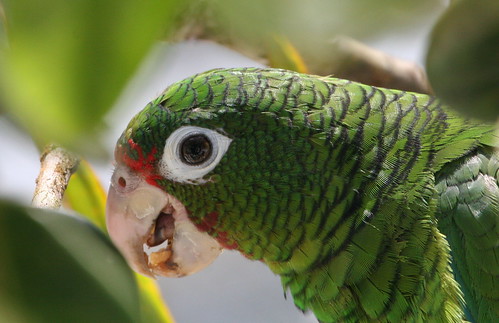 Endangered Puerto Rican parrot. Photo by Tom MacKenzie, USFWS
Endangered Puerto Rican parrot. Photo by Tom MacKenzie, USFWS
At least three captive raised Puerto Rican Parrots reintroduced in the Rio Abajo Forest flew east and are commingling with a flock of about 150 Orange-winged parrots (Amazona amazonica) in Morovis, Vega Baja and Manatí. The birds have been observed using mostly the karst region in these three municipalities.
The discovery was made when a man in Morovis, was looking at a group of exotic birds that often fly by his home, when he spotted one odd parrot with a wire around its neck, so he called the Puerto Rico Department of Natural and Environmental Resources (PR DNER) to report his siting. Turns out, the wire was the antenna of a radio transmitter. When biologists visited the site and used their radio telemetry equipment, the signal confirmed that it was one of the Puerto Rican Parrots released in the Rio Abajo Forest. Further observation revealed that at least two other Puerto Rican Parrots are in this flock of exotics that are abundant throughout the island. Both the USFWS and the PR DNER are closely monitoring the parrots. This remarkable discovery adds a whole new dimension to management of the Puerto Rican Parrot Recovery Program, because of the possibility of interbreeding, competition for resources and diseases. However, this situation does not alter our recovery goals and criteria at this time. We will not bring these parrots back to the aviaries or to the release site. The plan is to capture these birds and install new radio transmitters so we can release them into the habitat that they selected and monitor their movement, habitat use and breeding behavior.
Captive breeding in 2012 was the most productive year in the project’s history
Working in close coordination, both the USFWS and PR DNER maintain a joint stock of 347 of captivity parrots at the two captive breeding facilities. We see an upward trend in breeding numbers that started in 2007 and remains solid for six years in a row (see graphic). We attribute the increased yield to improved breeding conditions because in 2007 the captive population in El Yunque moved from an old military facility at the top of the Luquillo mountains to the Iguaca Aviary at a lower elevation. The Iguaca Aviary gives the parrots an environment that increases the survivability of chicks, lowering the risk of diseases in the population and provides parrots with a more natural scenario for breeding. The Iguaca Aviary also has state-of-the art equipment and outdoor cages that are spread out across a ½ acre property. Confinement was a big limiting factor in the old Luquillo aviary. Increased space helps reduce breeding adults from becoming aggressive towards the mate and their chicks. Also the flight cages have become an excellent tool for training birds for upcoming releases into the wild.
We continue to carry out surveys of the two established wild populations.. In 2012, the wild population in El Yunque National Forest remains unchanged from previous years at 20 to 25 birds and the population in Rio Abajo Forest is estimated between 49 and 78 birds (variation based on detectability).
Outreach
Efforts to build awareness and support for the species have intensified beyond Puerto Rico’s borders. For educational purposes, we are exploring the possibility of transferring a non-breeding pair of parrots to Disney’s Animal Kingdom where they would serve as ambassadors helping to raise awareness for the plight of the Puerto Rican Parrot recovery with millions of people that visit these parks on a yearly basis. At the present time, visitors to the Puerto Rico Zoo get to see a Puerto Rican parrot.